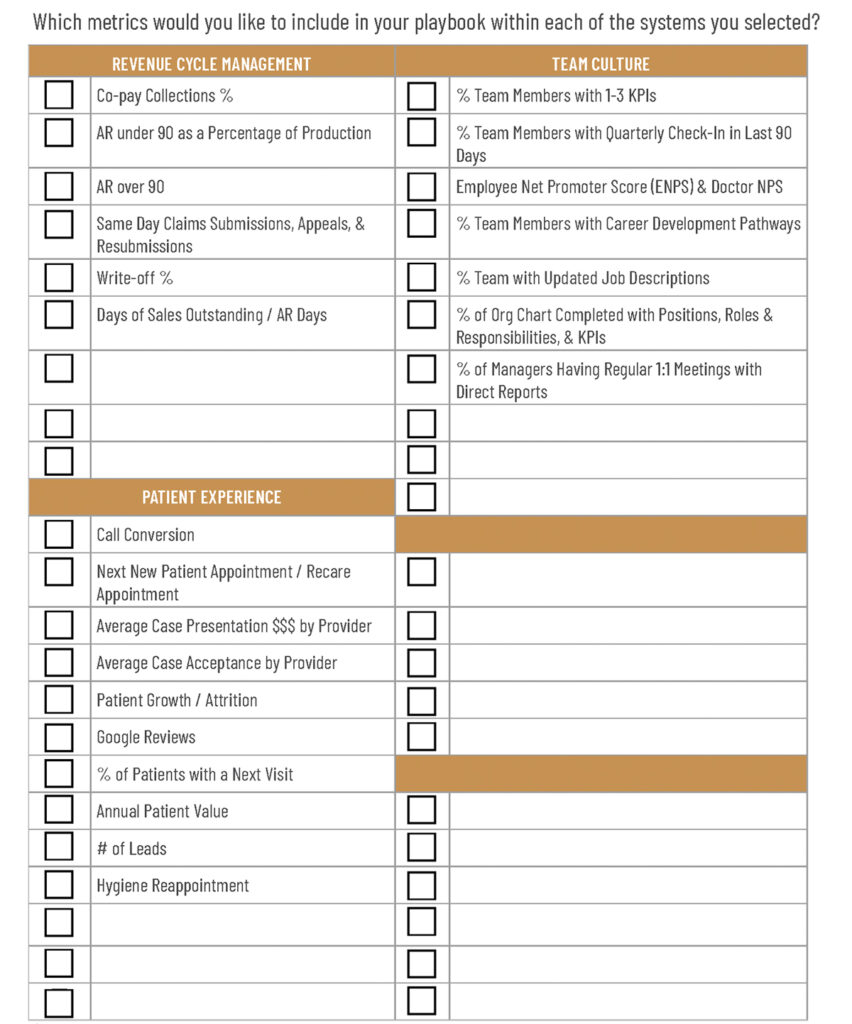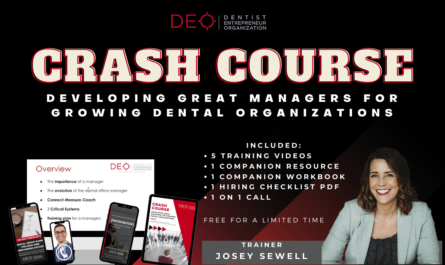How to use systems to turn scoreboard data into positive change within your organization.
There’s no ‘I’ in team, as the saying goes, but with today’s workforce dynamics, leading a successful operation for dental leaders comes with its share of pitfalls and headaches.
For some dental leaders, it may feel as though right when an employee is fully trained, they decide to leave, and the training process must start all over again. Or, the frustration is when employees that are trained and aware that tracking certain goals and maintaining them is important may be unable to take the actions necessary to get a desired outcome. Perhaps worst of all is the scenario of a high-performing but toxic team member who has the expert knowledge needed to operate a part of the business, but is holding the organization back with demands or disgruntled behavior.
If, however, a team has an outlined set of steps they can take to achieve desired outcomes, then the operation to get there can become more “automagic” for everyone. Indeed, a clearly defined operations playbook built to achieve desired solutions within a dental practice will give your team more clarity, empower them with decision-making abilities, and provide actionable steps individuals and departments can follow to solve problems on their own. These systems give staff a framework to make numbers and data within a dental practice go from red to green.
What are the benefits of workplace systems?
These systems, better known as an “operations playbook,” are similar to the idea of a playbook used by athletic teams to run plays and refer to when adjustments need to be made. The operations playbook outlines what a company should focus on, act toward, and improve on to get to “win” in business.
Leaders often tell employees to work harder, without giving them specific action items to complete. With an operations playbook, teams and individual employees can have a better understanding of how to succeed within their positions and as a business. Creating a playbook moves the business forward, allowing leaders and office managers to focus on other aspects of the business instead of always having to train, retrain and micro-manage employees. Instead, dental teams will know what their day-to-day actions are and steps to take to address a problem.
Actionable information
An operations playbook is simply a set of responses to conditions within the workplace. To start developing a playbook, dental leaders should brainstorm common tasks that teams should accomplish throughout the day. Document them in writing, and start by giving teams a list of when X occurs, do Y.
Another way to think of it is when life gives us lemons, dental leaders show their teams how to make lemonade via the playbook. The idea here is that ‘lemons,’ or actionable work items, are presented every day. Dental leaders should show their employees how to turn these opportunities into ‘lemonade,’ or achieving desired outcomes, so that everybody can perform at the best of their ability.
A strong operations playbook establishes standards for quick, actionable, and timely data. Data in a dental operations playbook should be reactionary, and documented quickly. This system can be set up in advance for staff, so that they know what is expected of them on a daily or weekly basis. Dental leaders can then meet with managers to do an audit, either weekly, once a month, etc., where they pull the data that has been measured, and determine steps to take going forward. The leader in this case may decide to make a coordinated plan to follow up until the team has the data.
If a scorecard item is off, the first step is to identify all the actions that could move the number from off to on. Then, leaders should take it one step further, putting those items in order of operation from the most effective to the least effective. Don’t save the best play for the end of the game in this case – run it right away to get everything done. Typically you’ll be able to solve the problem in the first, second or third action.
The playbook can be adjusted when employees have tried an action many times and are not achieving the desired outcome. Certain steps can also be designed to be delegated to other employees and applied throughout the company to ensure both leaders and team members are contributing to the ultimate outcome.
The practice’s playbook should be available to everyone, easily accessible, and part of an employee’s onboarding, regular training procedures, and something that everyone at the company refers to so that everyone is up to date and achieving their KPIs. The playbook can be a piece of paper sitting at the front desk, an online document, an icon on each employee’s computer, or whatever works best that allows the steps to be readily available when needed. Once team members follow the playbook two or three times, it becomes second nature.

| A Strong Operations Playbook: 1. Establishes standards for timely data 2. Identifies actions you take to move data points from off to on 3. Puts the actions in order from most important to least important 4. Is available to everyone who needs to use it 5. Sets the expectation that those actions will be taken before your team talks to you about a number being off. |
Customized data
Production equals patient care. Help bring that to life within the company’s playbook by allowing creativity in the structure and goals of the guide. This can be achieved by incorporating a company’s unique core values, vision, or overall culture into the daily operations.
For example, if there was a step in the playbook relating to patient experience, such as call conversion or scheduling, an employee could tie that step back to the company’s overall vision of creating impressionable and lasting impact with patients.
It is important to focus on bringing your company values to life through the goals and business operations outlined in the playbook. Implementing these measures steadily, and not overwhelming the staff members with all of them once, is also key.
Implementing a playbook with a team is a collaborative process. Inform your team of the reasons for the operations, and ensure they understand why it is being implemented. Also, engage team members by asking what they think could be introduced to make their jobs more systematic. Ensure that the operations are being implemented to help them, and not make their jobs harder.
Working through implementing changes with staff, sparking motivation and excitement as leaders, aligning it to the company’s overall vision, and understanding staff’s needs and what’s important to them will all help a practice achieve success when implementing systems.





